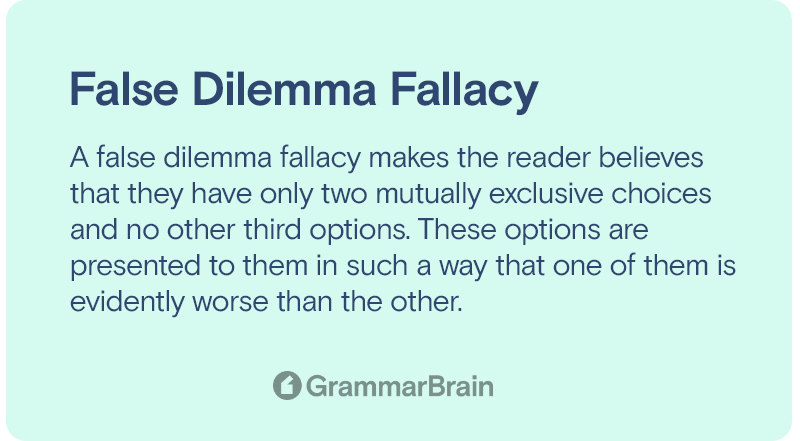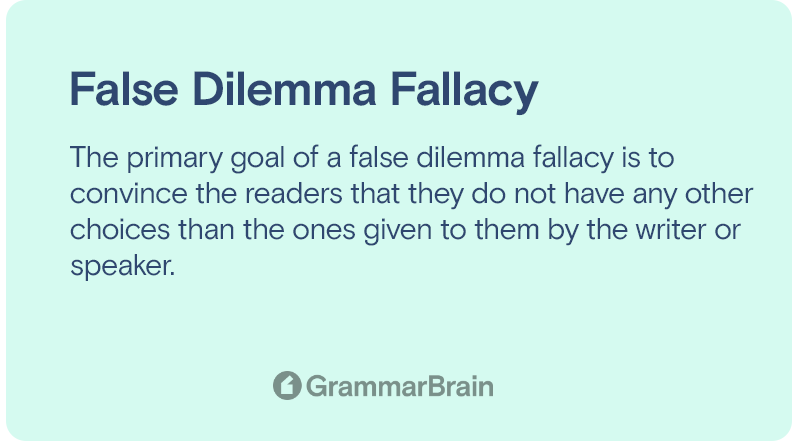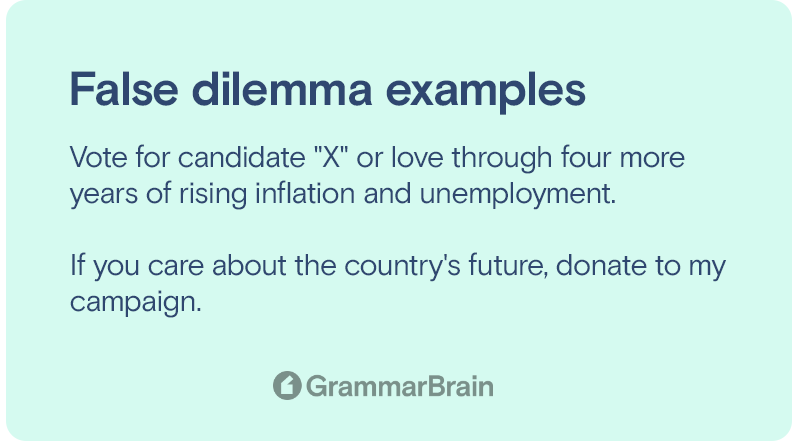A false dilemma is an informal fallacy that falsely presents a situation by proposing only two mutually exclusive options instead of the complete range of options. As per Wikipedia – “a false dilemma is an informal logical fallacy that erroneously limits what options are available.”

What exactly is the false dilemma fallacy?
A false dilemma fallacy makes the reader believes that they have only two mutually exclusive choices and no other third options. These options are presented to them in such a way that one of them is evidently worse than the other.
Thus, it persuades the reader or listener to make the obvious choice the writer or speaker intended them to. The false dilemma fallacy is also known as the “either/or” fallacy. This is because it presents a scenario with two options where one option is the natural “good” choice.

What is the purpose of the false dilemma fallacy?
The false dilemma fallacy has been used in the English language for a very long time. There are several specific instances where a false dilemma fallacy is deliberately used. While other times, it can show up due to the ignorance of the writer or speaker.
The primary goal of a false dilemma fallacy is to convince the readers that they do not have any other choices than the ones given to them by the writer or speaker.
By limiting the number of options, the false dilemma fallacy creates an either/or situation in the minds of the reader or listener. It makes them believe that the two available options are their only choices and one of them is obviously better than the other.
What are the types of false dilemma fallacy?
A false dilemma fallacy is usually divided into the following two types:
1. Disjunction with contraries
Disjunction with contraries presents two options that cannot be true at the same time. When used in an “either-or” choice, disjunction with contraries represents a false dilemma fallacy. In fact, this is one of the most common types of false dilemma fallacy usually used in political and advertising scenarios.
Some examples of this type of false dilemma fallacy include the following:
Sentences like these are incredibly common in political scenarios. Politicians encourage the voters to choose them or they might have to suffer some great ordeal. However, this is hardly true because the voters have plenty of other options in the form of other candidates.
Here’s another example of this type of false dilemma fallacy :
- You can either buy our dog food or your dog will remain sad forever.
Sentences like these are common in product advertising. In order to influence people to buy their products, brands often tell people that buying their products is the only “good” option for them.
While in reality, there are plenty of other choices. For example, the readers can buy dog foods from other brands, cook their dog’s favorite food at home, or choose several other options available to them,
2. Logical forms
False dilemma fallacy is also present in logical form. When we talk about logic, two main types of dilemmas can be found. These include constructive dilemmas and destructive dilemmas. These dilemmas can be represented with the help of the following symbols:
- Constructive dilemma: If A then B, and if C then D
- Destructive dilemma: Either A or B
Let’s have a look at some examples to better understand this type of false dilemma fallacy:
- If I bake muffins, then my daughter will be happy; If I bake cookies then my son will be happy.
- Either you buy chocolates, or you buy chips.
Logical forms of false dilemma fallacy are different from the disjunction with contraries fallacy in the sense that in the latter, both options can be true at the same time.
What are some common examples of false dilemma fallacy?
Generally, a false dilemma fallacy can be found wherever the writer has used rhetoric. Whenever a person wants to pursue others, they can do so by using the false dilemma fallacy and limiting their choices.
Usually, the false dilemma fallacy is used in political campaigns, advertising, and in “would you rather” arguments.
Let’s have a look at some common scenarios and examples of false dilemma fallacy:

1. Examples of false dilemma fallacy in political claims and campaigns
- Vote for candidate “X” or love through four more years of rising inflation and unemployment.
- If you care about the country’s future, donate to my campaign.
- Do you want unemployment to rise? If not, then vote for me.
2. Examples of false dilemma fallacy in a “would you rather” situation
- Would you rather start a business or be stuck in a boring job?
- Would you rather eat the salad or sleep hungry at night?
- Would you rather invest in stocks or travel the world?
3. Example of false dilemma fallacy in advertising
- If you want to have smooth and shiny hair, buy our shampoos.
- Subscribe to our streaming service or get bored with your old cable TV
- If you don’t buy our health supplements, you will never be able to lose weight.
Is false dilemma fallacy ever useful?
The popular belief is that the false dilemma fallacy is always used to influence the readers to make a favorable choice by limiting the number of options. While this is true in many scenarios, it isn’t the complete truth.
In reality, the false dilemma fallacy can also be harmless in various situations. In fact, it can help the readers or listeners in various scenarios.
Let’s look at some of the cases where the false dilemma fallacy can actually be useful.
1. Situation with too many options
When choices are genuine, simplifying and narrowing them down can help in saving time and confusion. This is especially helpful in situations that have an overwhelming number of options like choosing a TV show genre, selecting desserts, and more.
Some examples of this include:
- Let’s watch either a thriller or a comedy TV show.
- We can either choose ice cream or go for pudding.
2. Situations where young children are involved
Toddlers and young children often find it hard to make a choice. In such a case, using the false dilemma fallacy can prove to be incredibly helpful. It simplifies the situation and helps the child in making a choice.
Here are some examples of the same:
- Do you want to wear yellow socks or blue ones?
- You can drink milk or you can drink hot chocolate.
- You can behave in the shopping mall or you can stay back at home.
3. Customer services
Customer service representatives and other experts in the industry frequently use the false dilemma fallacy to help customers in making a choice. By presenting a limited number of options, customer service executives make the decision-making process a lot quicker and easier for the customers.
Here are some examples:
- Would you like to take salad or onion rings with your burger?
- Would like room service or would you like to opt for the buffet?
To conclude, while the false dilemma fallacy can be harmless and even helpful in certain cases, speakers and writers should try to avoid limiting the number of options. Unless writing for a political campaign or advertisement copies, it is recommended to write clearly and let the readers know about all the choices available to them.
FAQs
1. How do you correct a false dilemma fallacy?
When writing in plain English, it is advisable to avoid using the false dilemma fallacy. It is because it can often influence the readers into making a choice without revealing the full range of options available to them.
To correct the false dilemma fallacy, writers must try to avoid “either-or” situations in their work. They can do this by not writing terms like “choose either A or B” with no third choice.
While either-or situations can be useful in certain arguments, it is better to avoid them when writing in plain English. Writers must always aim to present the full range of possibilities to the readers.
2. What is another term for a false dilemma?
As per Wikipedia, the false dilemma is also sometimes called false dichotomy or false binary. It is basically a logical fallacy that creates a false premise where only two mutually exclusive options are available to the readers or listeners.
3. How does the false dilemma fallacy work?
The main goal of the false dilemma fallacy is to influence the reader into making a choice (which is often in the writer’s favor) by skewing their understanding of a topic.
The fallacy achieves this by limiting the number of options available to them. This ultimately leads the readers to make a choice or agree with things they wouldn’t normally have if the full range of possibilities was available to them.
Thus, the false dilemma fallacy works by presenting only two mutually exclusive options to the readers and skewing their understanding of an issue.
Sources:
- Wikipedia – Definition
- Grammarly – False Dilemma Fallacy
- Your Dictionary – False Dilemma Fallacy Examples
Inside this article
Fact checked:
Content is rigorously reviewed by a team of qualified and experienced fact checkers. Fact checkers review articles for factual accuracy, relevance, and timeliness. Learn more.
Core lessons
Glossary
- Abstract Noun
- Accusative Case
- Anecdote
- Antonym
- Active Sentence
- Adverb
- Adjective
- Allegory
- Alliteration
- Adjective Clause
- Adjective Phrase
- Ampersand
- Anastrophe
- Adverbial Clause
- Appositive Phrase
- Clause
- Compound Adjective
- Complex Sentence
- Compound Words
- Compound Predicate
- Common Noun
- Comparative Adjective
- Comparative and Superlative
- Compound Noun
- Compound Subject
- Compound Sentence
- Copular Verb
- Collective Noun
- Colloquialism
- Conciseness
- Consonance
- Conditional
- Concrete Noun
- Conjunction
- Conjugation
- Conditional Sentence
- Comma Splice
- Correlative Conjunction
- Coordinating Conjunction
- Coordinate Adjective
- Cumulative Adjective
- Dative Case
- Determiner
- Declarative Sentence
- Declarative Statement
- Direct Object Pronoun
- Direct Object
- Diction
- Diphthong
- Dangling Modifier
- Demonstrative Pronoun
- Demonstrative Adjective
- Direct Characterization
- Definite Article
- Doublespeak
- False Dilemma Fallacy
- Future Perfect Progressive
- Future Simple
- Future Perfect Continuous
- Future Perfect
- First Conditional
- Irregular Adjective
- Irregular Verb
- Imperative Sentence
- Indefinite Article
- Intransitive Verb
- Introductory Phrase
- Indefinite Pronoun
- Indirect Characterization
- Interrogative Sentence
- Intensive Pronoun
- Inanimate Object
- Indefinite Tense
- Infinitive Phrase
- Interjection
- Intensifier
- Infinitive
- Indicative Mood
- Participle
- Parallelism
- Prepositional Phrase
- Past Simple Tense
- Past Continuous Tense
- Past Perfect Tense
- Past Progressive Tense
- Present Simple Tense
- Present Perfect Tense
- Personal Pronoun
- Personification
- Persuasive Writing
- Parallel Structure
- Phrasal Verb
- Predicate Adjective
- Predicate Nominative
- Phonetic Language
- Plural Noun
- Punctuation
- Punctuation Marks
- Preposition
- Preposition of Place
- Parts of Speech
- Possessive Adjective
- Possessive Determiner
- Possessive Case
- Possessive Noun
- Proper Adjective
- Proper Noun
- Present Participle
- Prefix
- Predicate



